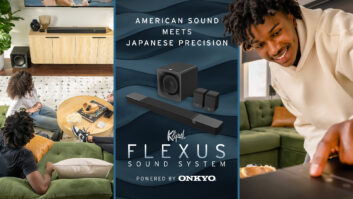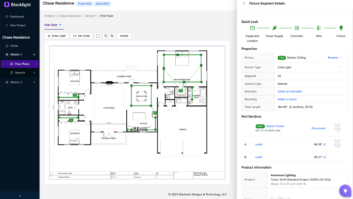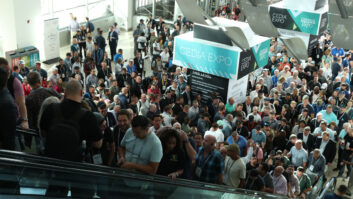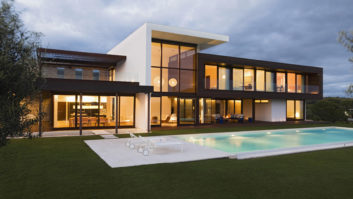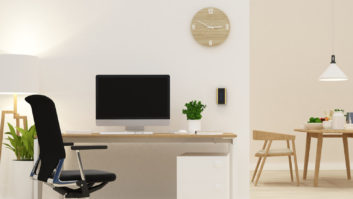There was a time, not long ago, when designing a custom control system for a residential audio-video integration project required at least one highly trained programmer and typically hours upon hours of code writing. Thankfully, those days are mostly over as even the most traditional of control systems manufacturers have begun offering streamlined drag-and-drop software packages and other intuitive tools for a wide-range of projects.
The challenge for all manufacturers in the control systems category is accommodating the integration of increasingly complex and feature-rich consumer products, while maintaining programming simplicity for dealers trying to survive turbulent economic times.
As Universal Remote Control Inc.’s VP of technology, Eric Johnson pointed out, today’s consumers, driven by lower prices advertised seemingly everywhere, want more flat screens, more speakers, more sources, more home entertainment electronics in more rooms. And, of course, they want easy, one-touch control of it all, everywhere in the house. Concurrently, a broadening assortment of control protocols has emerged, including devices that are IP-controlled, IR, RF—some via relays/trigger voltages and some by RS-232.

For its top-of-the-line MX-6000 Touch Screen, URC has created an environment where integrators can program an entire house full of remotes, simple base stations, and complex controllers via a room-based system with one master file and one software application.
“The growing American appetite for diverse components—coupled with a chronic lack of standards— means that now, more than ever, the custom installer is the missing ingredient among the huge array of devices consumers would like integrated,” Johnson said. “Our job as a manufacturer is to make CI professionals more productive by providing control system design software that can enable them to maximize their efficiency.”
URC SIMPLIFIES
During the past year, URC has accomplished a lot with its OpenArchitecture control system programming. For its top-of-the-line MX- 6000 Touch Screen, the company has created an environment where integrators can program an entire house full of remotes, simple base stations, and complex controllers via a room-based system with one master file and one software application. On its mid-priced remotes, additions include color screens, variables for tracking users, events and more, plus drag-and-drop customization and fast form-based labeling of color icons. Additionally, URC has kept speed-programming features like an IR database that saves all commands without having to drag and drop even one code. On the company’s MX-450—the least-expensive remote in its professional line—macros can be edited on the remote itself.
RTI’S EVOLUTION
RTI’s VP of sales and marketing Pete Baker has found that his company’s software must evolve harmoniously with new enhancements like WiFi, higher resolution color screens, and the addition of new levels of control and communication options. “The challenge, which we enjoy, is to address these very advanced aspects of control and make the process as efficient and intuitive as possible,” he said.
RTI’s recently renamed Integration Designer software is the cornerstone of the its goals of offering a full line of control solutions to integrate all electronic systems into one control platform, Baker explained. “We also have invested heavily into providing even more professionally designed graphics, offering the integrator, and ultimately the consumer, more choices for the look of the interface,” he said.

RTI’s recently renamed Integration Designer software The company’s new RS-232 library allows an integrator to drag and drop RS-232 codes from a library onto buttons of the control device. Future enhancements include support for two-way control on many of RTI’s devices.
CRESTRON ADDRESSES VARIABLES
Crestron has expanded its focus beyond proprietary programming with, among other tools, its SystemBuilder software. It is designed to handle all of the low-level complexities of metadata and scrolling media lists, while hiding the complicated details from the end-user.
“SystemBuilder provides icons that the programmer can just drag and drop into the project folder, which automatically builds GUI pages and all the programming,” explained Crestron’s marketing communications director Jeff Singer. “Programmers can still add, remove, and modify any part of the programming and the graphical UI on the touchpanel.”
Crestron also has added a concept called, “device variables,” which makes programming easier for sophisticated projects. After programming only one device, a programmer can apply that logic to every other device rather than programming each one manually. Other new Crestron programming features include an easy method to comment on each programming step, the ability to categorize global presets, and a built-in scrolling list object for the APAD UI.
UEI’S IPOD ANSWER

UEI’s SuperFast Device Swap enables an integrator, in a single step, to replace all commands for one device with another device throughout every button and macro in the installation.
Universal Electronic Inc.’s senior product manager, Steve Clegg, said that his company’s pending release of NevoStudio Pro (scheduled for fourth quarter, 2008) will address iPod dock compatibility and the growth of Z-Wave home control devices in custom installation. NevoStudio Pro 2.0 will provide a two-step setup to enable two-way communication with specific iPod docking stations from iPort and Escient.
Z-Wave functionality was added in response to a growing number of lighting and HVAC controllers using that particular RF-based wireless technology. “The software comes with a number of pre-made two-way widgets, such as light switches, thermostat displays, and status widgets to indicate the current state of doors, blinds, windows, and HVAC.” Clegg said. “Programming involves simply dropping a single command onto the widget, and it’s ready for twoway communications.”
UEI’s SuperFast Device Swap enables an integrator, in a single step, to replace all commands for one device with another device throughout every button and macro in the installation.
Additional programming features from UEI include page-collection wizards, auto image resizing for background images, drag-and-drop themes, and SuperFast Device Swap, which enables an integrator, in a single step, to replace all commands for one device with another device throughout every button and macro in the installation.
HAI’S ENERGY SOLUTION
At the same time that HAI is addressing the consumer demand for more energy management solutions, the soon-to-be-released Version 3.0 of its controller firmware and PCAccess software is being created to make system design easier in several ways. “We’ve made it easier for customers to make adjustments to their systems (wake up times, “away” temperatures, holidays, for example) without changing the system’s programming,” said HAI’s president and CEO Jay McLellan.

HAI’s soon-to-be-released Version 3.0 of its controller firmware and PCAccess software should make systems design easier in several ways. According to McLellan, the program’s layout features a “tree” on the left side of the screen showing “where you are” in the program, and how the system looks overall. As dealers set up each attached device, the available options, device names, and settings are shown on one page. Additionally, the printout from PCAccess 3 gives dealers a well-documented statement of how the system is set up and programmed. New commenting for programs and descriptions for devices give the dealer an easy way to archive a system as-built.
There also is greater flexibility and less repetition required for complex macros and programming strategies on HAI control systems. Further, a new “auto-completion” feature allows proficient programmers to type the first few letters of a program line. Last but not least, along with controller firmware version 3, new commands
and conditionals allow dealers to write more innovative programs for their clients.
VANTAGE’S ADVANTAGE
Vantage/Legrand prides itself on leading the trend toward more dealer- friendly programming software, explained marketing communications manager, Derek Jensen. With the introduction of its Design Center program in 2006 and embedded components, called Touchscreen Designer and InFusion Media, the company has been providing software that is meant to be very simple and easy to use. “With minimal training, Vantage dealers can design and commission complex lighting and automation systems,” Jensen said.
Vantage has introduced two new touchscreens this year, and one more will be released in November. “Along with programs that contain templates for easy-to-create touchscreen interfaces, we also have been incorporating pre-programmed widgets to deliver control of lighting, music, photos, cameras, the Internet, and a customizable weather display,” Jensen added.
SAVANT’S SAVVY
The size and complexity of many of the projects that Savant dealers are involved with has influenced the evolution of the manufacturer’s Racepoint Blueprint design software. We are focusing on the installer’s workflow in Blueprint to make sure they can make customizations and changes as efficiently as possible,” said Savant president Jim Carroll. “One example is making it easier to replicate or share a customization to a user interface device (like a touchpanel) across a number of similar screens, so the installer makes the change in just one place and has it effect a number of screens.”

Along with programs that contain templates for easy-to-create touchscreen interfaces, Vantage also has incorporated preprogrammed widgets.
Savant is adding several tools to its Racepoint Blueprint application to make integration of programmable devices (such as lighting and security systems) much simpler. One example is that Blueprint will accept exported configuration files from these devices in a number of formats (such as XML) and import them directly into the Blueprint document. Another example is improving the data entry in Blueprint to better manage information regarding programmable devices.
ELAN MAKES IT EASIER
The role of any custom integration professional is to find a way to make disparate products work together seamlessly and effectively for their clients. From HD video distribution switchers to RS-232- controlled lighting, security, climate, and pool and spa products, ease of integration has become on of the most important aspects of any dealer programming tool, noted ELAN’s president and chief technical officer Bob Farinelli. ELAN is developing a whole new dealer setup software package, called ELANTOOLS, in response to its dealer requests.
“Slated for release in early 2009, just some of the key enhancements with this release will be the incorporation of many new features that facilitate this trend and need for expanded integration,” Farinelli said.
Farinelli described many features and time-saving elements that ELAN hopes will make dealers’ lives easier. A feature called “Auto Fill” gives a programmer the ability to associate any device (cable box, CD, DVD, tuner, alarm, etc.) to a button, page, or an entire template (multiple pages and buttons). Once this is done, serial or IR commands automatically fill in. “The beauty of this is if/when the dealer needs to switch out a device, for example a cable box, all they have to do is re-associate to the new model number and all of the commands will be switched out automatically,” he explained.
THE COLORADO VNET EXPERIENCE
Every company has its own way of simplifying the programming process, and Colorado vNet may have one of the most compelling solutions. The company’s vNet Builder package is promoted as the only floor plan-based design software in the industry. According to product manager Scott Stephenson, the Denver-based manufacturer has focused from the beginning on making it extremely easy to learn and to use.
“Our customers have told us that it can take a quarter of the time to program a complete lighting and control system with vNet Builder as it would to program comparable systems,” he said.
Additionally, the built-in simulator means that the programming can be thoroughly tested and demonstrated to the homeowner before the first device is even installed.”
The new version of Colorado vNet’s software, which is coming out soon, is being designed to better handle “conditional logic” scenarios in lighting control such as proper times of day when a motion sensor should and should not turn on the lights or at what percentage the lights should come up.
CONTROL4’S MARKET VIEW
From the beginning, Control4 recognized the appeal of creating a system that didn’t require a lot of initial programming to work out-of-the box. Their system does, however, allow for total customization using a programming structure that’s non-language specific.
“In addition to simple programming, the software incorporates drag-and-drop functionality to speed up the programming process with many of the potential icons and screens pre-built in the system,” said Control4’s chief technology officer Eric Smith.

Colorado vNet’s “vNet Builder” programming software features a built-in simulator that enables programming to be tested and demonstrated to the homeowner. Control4’s system has provisions for new products with two-way communication capabilities entering the market. Dealers can use DriverWorks, a tool that gives dealers the flexibility to create new two-way drivers that integrate third-party products and systems into the Control4 platform.
RUSSOUND’S UPGRADE PATH
For many companies, the ability to react to the constantly changing product landscape has been simplified somewhat by their ability to provide dealers with programming software upgrades throughout the year.For example, Russound dealers can use the company’s configuration software to detect a newer version of the control package for its ACA-E5 ulti-zone controller amplifier.
“The controller can then be asked to download the software and update the system by a simple click of the mouse,” said Russound’s VP of engineering Rajeev Argarwal. “The installer also has the ability to remotely log into an ACA-E5 from anywhere in the world to configure it or update its software.”
Russound’s configuration software features design wizards and built-in templates that allow rapid installation out of the box. For greater customization, the integrator also can drill down into a more programmable set up.
AMX OFFERS A CHOICE
The challenge, in the end, according to AMX’s VP of marketing, Jeff Kindig, is to simplify the design process while preserving customization for the customer. The answer, he explained, is to give integrators options on ways to execute the design processes.
“With those choices comes a trade off—flexibility to customize the system with the opportunity to complete more jobs in a shorter timeframe,” Kindig added.
On one end of the spectrum, AMX NetLinx Studio offers integrators a tool to ensure flexibility to program the system to do anything. Next in line is VisualArchitect, which offers a visual drag-and-drop environment with all the necessary components to complete a system in less time. Next, AMX has a System Design Library of projects tailored to specific applications within different vertical markets that are already designed and only require minimal modifications to complete. Finally, AMX has created a new line of software tools called AMXhome and AMXmeetingroom that continue to simplify the system design process taking even less time to complete.
Jeremy J. Glowacki serves as editorial director for New York City-based Residential Systems magazine, from a satellite office in Carmel, Indiana.
INTRODUCING BITWISE CONTROLS
Bitwise Controls, a relative unknown in the CI channel direct-dealer program to support its BC4 standards-based control system network interface. BC4 has been designed to offer dealers the options and advantages of installing IP-based software and controls with modular I/O Expansion, Power-Over-Ethernet and robust, and two-way TCP or UDP communications, to control and monitor almost any hardware device available. Designed for compatibility with all popular control systems, it incorporates features like configurable analog/digital GPIO, relay outputs, an IR engine with a preprogrammed library and learning, and a two-way command protocol.
